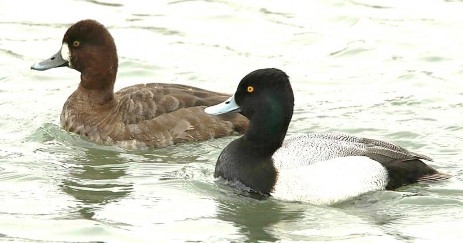The Problems of Avian Predators on Fish Farms: Scaup on Baitfish (Golden Shiner) Farms
ID
AAEC-191NP

Baitfish farmers raise several different species of fish, often called minnows, to sell as live bait for anglers across the United States. The most popular and commonly raised baitfish species is the golden shiner. Many baitfish farms are located within a major flyway used by migrating birds. A variety of different migratory birds arrive at baitfish farms each fall, feed on fish on the farms, and then depart on spring migration. Baitfish farmers have reported major losses of fish from these avian predators.
The Southern Regional Aquaculture Center funded a project to specifically measure the impacts of two avian predators on baitfish farms: Lesser Scaup and Greater Scaup. Scaup depredation is highly variable and fluctuates annually and even from farm to farm based on weather patterns, prey availability, and other factors. The following information on scaup depredation on golden shiners is based on research conducted in winters (November-March) 2016-2017 and 2017-2018. Given that Arkansas produces a high percentage of U.S. farmed baitfish, the study focused on Arkansas baitfish farms.
Scaup arrive in central Arkansas in November and remain through March. During this time, as many as 66% of all ponds in the major baitfish farming region of Arkansas (approximately 748 ten-acre ponds) were used by scaup and as many as 225 scaup have been observed on a single pond.
The winter of 2016-2017 was unusually warm, there were few scaup, and few fish were consumed by scaup. The winter of 2017-2018, however, was much colder, there were more scaup, and they ate many more fish. We found that during peak periods of fish consumption (December-February, 2017-2018), as many as 51% of the scaup sampled during the study contained fish. Hence, many of the scaup that were observed on baitfish farms were definitively eating the farm’s golden shiners.
We found that an individual scaup can consume about 0.5 lb of fish or over 300 individual golden shiners per day.
Based on the number of scaup present on a farm and fish consumption throughout the winter of 2017-2018, losses per acre on ponds containing scaup averaged 37,600 golden shiners (estimated range = 16,600 to 58,700 fish/acre)
Although other types of birds also eat farmed fish, the average amount of fish consumed by scaup alone corresponded to losses of about 25% of the fish crop. This percentage varied across farm ponds, where losses of the fish crop were as low as about 8% and as high as 59%.
Many other fish-eating birds were observed consuming fish on baitfish farms, including Great- blue Herons, Great Egrets, and Double-crested Cormorants. As the study progresses, estimates of the total amount of baitfish lost to avian predators will become available.
Losses of baitfish to avian predators occur despite intensive efforts by baitfish farmers to scare birds from their farms. This same study found that baitfish farmers spend approximately $250/acre each year to attempt to scare avian predators from their farms.
Losses of golden shiners eaten by scaup resulted in lost revenue of $50/acre in the colder Year 2 winter. The combined economic effect of lost revenue from fish losses and the expense of scaring birds decreased overall profit margins by $251/acre (years with few birds) to $300/acre in colder years when birds arrive to feed on baitfish on farms. For the median size of golden shiner farm of 800 acres, this represents economic losses of $200,800 per farm in years with few birds and $240,000 per farm in years with high bird pressure.
Acknowledgment
Funding was provided in part by the Southern Regional Aquaculture Center through Grant number 2016-38500-25752 from the U.S. Department of Agriculture National Institute of Food and Agriculture.
Virginia Cooperative Extension materials are available for public use, reprint, or citation without further permission, provided the use includes credit to the author and to Virginia Cooperative Extension, Virginia Tech, and Virginia State University.
Virginia Cooperative Extension is a partnership of Virginia Tech, Virginia State University, the U.S. Department of Agriculture (USDA), and local governments, and is an equal opportunity employer. For the full non-discrimination statement, please visit ext.vt.edu/accessibility.
Publication Date
July 26, 2024



